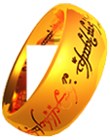Things of Middle-earth
Smial
Type: Miscellaneous
Other Names: hobbit-hole
Description:“All Hobbits had originally lived in holes in the ground, or so they believed, and in such dwellings they still felt most at home; but in the course of time they had been obliged to adopt other forms of abode. Actually in the Shire in Bilbo's days it was, as a rule, only the richest and the poorest Hobbits that maintained the old custom. The poorest went on living in burrows of the most primitive kind, mere holes indeed, with only one window or none; while the well-to-do still constructed more luxurious versions of the simple diggings of old. But suitable sites for these large and ramifying tunnels (or smials as they called them) were not everywhere to be found. . .”
Prologue, pg. 24, The Fellowship of the Ring
“Not a nasty, dirty, wet hole, filled with the ends of worms and an oozy smell, nor yet a dry, bare, sandy hole with nothing in it to sit down on or to eat: it was a hobbit-hole, and that means comfort.”
An Unexpected Party, pg. 9, The Hobbit
“It had a perfectly round door like a porthole, painted green, with a shiny yellow brass knob in the exact middle. The door opened on to a tube-shaped hall like a tunnel: a very comfortable tunnel without smoke, with panelled walls, and floors tiled and carpeted, provided with polished chairs, and lots and lots of pegs for hats and coats - the hobbit was fond of visitors. The tunnel wound on and on, going fairly but not quite straight into the side of the hill - The Hill, as all the people for many miles round called it - and many little round doors opened out of it, first on one side and then on another. No going upstairs for the hobbit: bedrooms, bathrooms, cellars, pantries (lots of these), wardrobes (he had whole rooms devoted to clothes), kitchens, dining-rooms, all were on the same floor, and indeed on the same passage. The best rooms were all on the left-hand side (going in), for these were the only ones to have windows, deep-set round windows looking over his garden and meadows beyond, sloping down to the river.”
An Unexpected Party, pg. 9, The Hobbit
“Their houses were usually long, low, and comfortable. The oldest kind were, indeed, no more than built imitations of smials, thatched with dry grass or straw, or roofed with turves, and having walls somewhat bulged. . . .”
“. . . . A preference for round windows, and even round doors, was the chief remaining peculiarity of hobbit-architecture.”
Prologue, pg. 25, The Fellowship of the Ring
Contributors: Still Anonymous, 03/08/04
